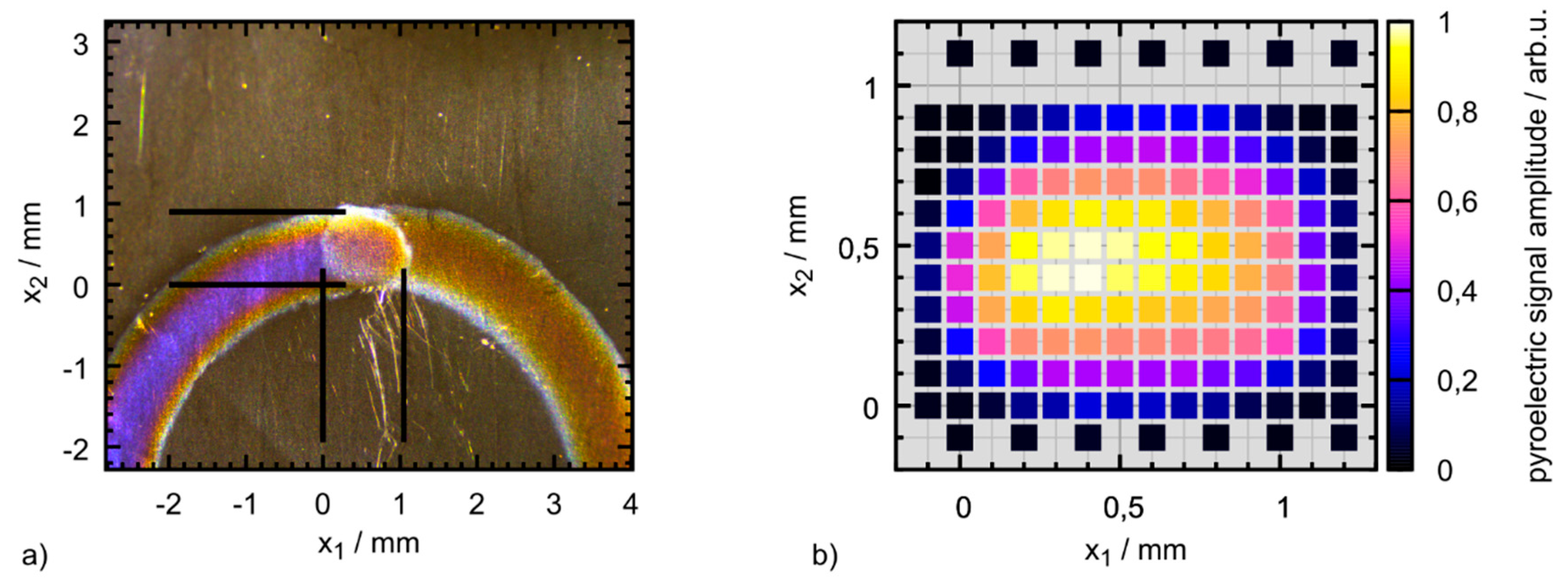Single Transparent Piezoelectric Detector for Optoacoustic Sensing—Design and Signal Processing
Abstract
:1. Introduction
2. Experimental Setup
2.1. Handheld Optoacoustic Setup
2.2. Design and Fabrication of the Optoacoustic Detector Film
2.3. Mapping the Active Area of the Detector
3. Measurement of the Instrument Response Function
3.1. Creating a Delta Peak Signal
3.2. Removing the Pyroelectric Signal from the Instrument Response Function (IRF)
4. Results of Raw Signal Processing and Deconvolution
5. Summary and Outlook
Author Contributions
Funding
Acknowledgments
Conflicts of Interest
References
- Wang, L.V. Photoacoustic Tomography and Microscopy. Opt. Photonics News 2008, 19, 36–41. [Google Scholar] [CrossRef]
- Ntziachristos, V. Going deeper than microscopy: The optical imaging frontier in biology. Nat. Methods 2010, 7, 603–614. [Google Scholar] [CrossRef] [PubMed]
- Tzoumas, S.; Nunes, A.; Olefir, I.; Stangl, S.; Symvoulidis, P.; Glasl, S.; Bayer, C.; Multhoff, G.; Ntziachristos, V. Eigenspectra optoacoustic tomography achieves quantitative blood oxygenation imaging deep in tissues. Nat. Commun. 2016, 7, 12121. [Google Scholar] [CrossRef] [PubMed] [Green Version]
- Zhou, Y.; Xing, W.; Maslov, K.I.; Cornelius, L.A.; Wang, L.V. Handheld photoacoustic microscopy to detect melanoma depth in vivo. Opt. Lett. 2014, 39, 4731–4734. [Google Scholar] [CrossRef] [PubMed] [Green Version]
- Jaeger, M.; Niederhauser, J.J.; Hejazi, M.; Frenz, M. Diffraction-free acoustic detection for optoacoustic depth profiling of tissue using an optically transparent polyvinylidene fluoride pressure transducer operated in backward and forward mode. J. Biomed. Opt. 2005, 10, 024035. [Google Scholar] [CrossRef] [PubMed]
- Li, H.; Dong, B.; Zhang, Z.; Zhang, H.F.; Sun, C. A transparent broadband ultrasonic detector based on an optical micro-ring resonator for photoacoustic microscopy. Sci. Rep. 2014, 4, 4496. [Google Scholar] [CrossRef] [PubMed] [Green Version]
- Zhang, E.Z.; Povazay, B.; Laufer, J.; Alex, A.; Hofer, B.; Pedley, B.; Glittenberg, C.; Treeby, B.; Cox, B.; Beard, P.; et al. Multimodal photoacoustic and optical coherence tomography scanner using an all optical detection scheme for 3D morphological skin imaging. Biomed. Opt. Express 2011, 2, 2202–2215. [Google Scholar] [CrossRef] [PubMed] [Green Version]
- Niederhauser, J.J.; Jaeger, M.; Hejazi, M.; Keppner, H.; Frenz, M. Transparent ITO coated PVDF transducer for optoacoustic depth profiling. Opt. Commun. 2005, 253, 401–406. [Google Scholar] [CrossRef]
- Stritzel, J.; Melchert, O.; Wollweber, M.; Roth, B. Effective one-dimensional approach to the source reconstruction problem of three-dimensional inverse optoacoustics. Phys. Rev. E 2017, 96, 33308. [Google Scholar] [CrossRef] [PubMed]
- Melchert, O.; Blumenröther, E.; Wollweber, M.; Roth, B. Numerical prediction and measurement of optoacoustic signals generated in PVA-H tissue phantoms. Eur. Phys. J. D 2018, 72, 1605. [Google Scholar] [CrossRef]
- Varkentin, A.; Mazurenka, M.; Blumenröther, E.; Behrendt, L.; Emmert, S.; Morgner, U.; Meinhardt-Wollweber, M.; Rahlves, M.; Roth, B. Trimodal system for in vivo skin cancer screening with combined optical coherence tomography-Raman and colocalized optoacoustic measurements. J. Biophotonics 2018, 11, e201700288. [Google Scholar] [CrossRef] [PubMed]
- Blumenrother, E.; Melchert, O.; Wollweber, M.; Roth, B. Detection, numerical simulation and approximate inversion of optoacoustic signals generated in multi-layered PVA hydrogel based tissue phantoms. Photoacoustics 2016, 4, 125–132. [Google Scholar] [CrossRef] [PubMed] [Green Version]
- Omelchert/LEPM-1DFD. Available online: https://github.com/omelchert/LEPM-1DFD (accessed on 8 May 2019).
- Melchert, O.; Wollweber, M.; Roth, B. An efficient procedure for custom beam-profile convolution in polar coordinates: Testing, benchmarking and application to biophotonics. Biomed. Phys. Eng. Express 2018, 4, 25025. [Google Scholar] [CrossRef]
- Melchert, O.; Wollweber, M.; Roth, B. Optoacoustic inversion via convolution kernel reconstruction in the paraxial approximation and beyond. Photoacoustics 2019, 13, 1–5. [Google Scholar] [CrossRef] [PubMed]
- Varkentin, A.; Mazurenka, M.; Blumenröther, E.; Meinhardt-Wollweber, M.; Rahlves, M.; Broekaert, S.M.C.; Schäd-Trcka, S.; Emmert, S.; Morgner, U.; Roth, B. Comparative study of presurgical skin infiltration depth measurements of melanocytic lesions with OCT and high frequency ultrasound. J. Biophotonics 2017, 10, 854–861. [Google Scholar] [CrossRef] [PubMed]






| Layer | Material | Sound Velocity [m/s] | Thickness [mm] |
|---|---|---|---|
| 1 | PMMA | 2777 | 5.00 |
| 2 | Adhesive | 2000 1 | 0.02 1 |
| 3 | PVDF | 2250 2 | 0.01 |
| 4 | Adhesive | 2000 | 0.02 1 |
| 5 | PMMA | 2777 | 0.5 |
| 6 | Ink | 1500 1 | 0.04 1 |
| 7 | Glass | 5640 | 4.00 |
© 2019 by the authors. Licensee MDPI, Basel, Switzerland. This article is an open access article distributed under the terms and conditions of the Creative Commons Attribution (CC BY) license (http://creativecommons.org/licenses/by/4.0/).
Share and Cite
Blumenröther, E.; Melchert, O.; Kanngießer, J.; Wollweber, M.; Roth, B. Single Transparent Piezoelectric Detector for Optoacoustic Sensing—Design and Signal Processing. Sensors 2019, 19, 2195. https://doi.org/10.3390/s19092195
Blumenröther E, Melchert O, Kanngießer J, Wollweber M, Roth B. Single Transparent Piezoelectric Detector for Optoacoustic Sensing—Design and Signal Processing. Sensors. 2019; 19(9):2195. https://doi.org/10.3390/s19092195
Chicago/Turabian StyleBlumenröther, Elias, Oliver Melchert, Jonas Kanngießer, Merve Wollweber, and Bernhard Roth. 2019. "Single Transparent Piezoelectric Detector for Optoacoustic Sensing—Design and Signal Processing" Sensors 19, no. 9: 2195. https://doi.org/10.3390/s19092195





